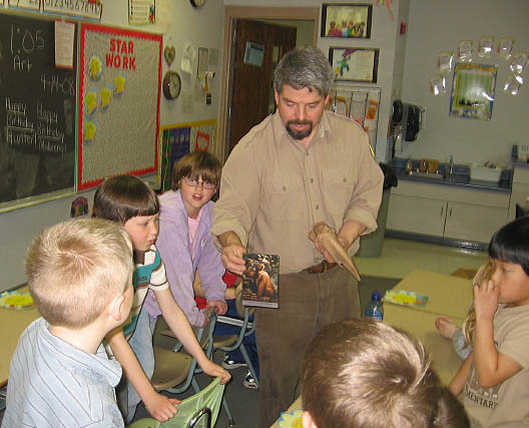Levitra and Levitra Orodispersible are tablets for erectile dysfunction. They are a popular alternative to other ED treatments, preferred by some men more susceptible to side effects. Levitra ODT is a type of erectile dysfunction tablet which quickly dissvoles on the tongue. The active ingredient is then absorbed into the bloodstream. They do not need to be taken with water like regular tablets do, so Levitra ODT may be preferred by those men who want a more discreet way of taking their ED medicine. Vardenafil is the working ingredient in Levitra. It functions by blocking an enzyme which can sometimes cause muscle walls to tighten and contract in those blood vessels at the entrance to the penis. – a drug designed for men with a reduced erectile function and sexual impotence. Thanks to the active ingredient vardenafil achieved by strengthening the potency and restored the health of the reproductive system. If you notice any changes in your vision while taking this drug, notify your prescriber or health care professional as soon as possible.
Category Archives: Miscellaneous
Walk Like a Sloth–lesson 4: the claw
Introduction to Walk Like a Sloth: lessons in ground sloth locomotion
 Getting Oriented
Getting Oriented
The claw is from the middle toe of the left foot. It’s the largest of all of the claws. In life the bony core would have been covered with a toenail growing out of the pocket or sheath at the wide end. The nail probably didn’t extend far beyond the tip. Sloth claws didn’t retract like a cat’s so a long nail would get in the way of planting the foot down flat and would have abraded quickly. Half of the nail sheath is missing from the specimen (broken off after burial) but the accident reveals the impressions left by the major blood vessels feeding the nail and penetrating into the interior through foramina (holes). The ventral tuberosity would have supported a tough pad of tissue on which the sloths walked, lifting the tip of the claw slightly off the ground. Continue reading
Dreamers and other peatland visitors
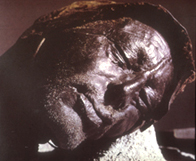 “This is one of the best examples of a spring marsh I have yet seen. . . ” wrote State Geologist Charles White about this Marion, Iowa fen in the course of his critical statewide survey of Iowa’s wetlands in the fall of 1867 (White, 1867). However, White didn’t come to admire the flora. The future of the State rested upon what he could learn here about turning this peatland into an urgently needed fuel source.
“This is one of the best examples of a spring marsh I have yet seen. . . ” wrote State Geologist Charles White about this Marion, Iowa fen in the course of his critical statewide survey of Iowa’s wetlands in the fall of 1867 (White, 1867). However, White didn’t come to admire the flora. The future of the State rested upon what he could learn here about turning this peatland into an urgently needed fuel source.
New dig photos
May 7 program details
Sloth Volunteers,
There will be a special program featuring the Tarkio Valley sloths kicking off the 150th anniversary of the Museum of Natural History, University of Iowa during the afternoon and evening of Thursday, May 7.
First, there will be an open house in the Paleontological Repository, where the University’s paleontological collection is housed, from 3:00-5:00 PM. This is informal and you can visit as you wish. Staff will be present to answer questions. This will be held in Trowbridge Hall which is one building north of the Pentacrest (Old Capitol area) and next to the Union parking ramp.
Greg McDonald speaking
Mark your calendars for Thursday, May 7.  Dr. Greg McDonald, Senior Curator of Paleontology for the National Park Service, renowned giant ground sloth expert, and consultant on the Tarkio Valley Sloth Project, will offer a lecture: The Museum and the Megalonyx: A History of Great Aspirations and Sloths in Iowa, at 7:00 PM in the Macbride Hall Auditorium on the University of Iowa campus. Meet Greg at a public reception before the lecture, from 6:00-7:00 PM, in the Iowa Hall gallery of the Museum of Natural History, Macbride Hall. Greg is an excellent speaker and a real sloth enthusiast. It will be an interesting and entertaining evening.
Dr. Greg McDonald, Senior Curator of Paleontology for the National Park Service, renowned giant ground sloth expert, and consultant on the Tarkio Valley Sloth Project, will offer a lecture: The Museum and the Megalonyx: A History of Great Aspirations and Sloths in Iowa, at 7:00 PM in the Macbride Hall Auditorium on the University of Iowa campus. Meet Greg at a public reception before the lecture, from 6:00-7:00 PM, in the Iowa Hall gallery of the Museum of Natural History, Macbride Hall. Greg is an excellent speaker and a real sloth enthusiast. It will be an interesting and entertaining evening.
McDonald’s lecture kicks off a year-long celebration of the 150th anniversary of the Museum of Natural History, the oldest museum in Iowa. Check the museum’s web site http://www.uiowa.edu/~nathist/ for details of other upcoming events. acheter aldactone
The little matter of elephant garlic
 McDonald (1977) was the first to note the similarity of Megalonyx teeth to those of VAMPIRE BATS. Like sloths, but unlike other bats and most other mammals, the common vampire bat, Desmodus rotundus, has teeth that are comprised entirely of dentin, with a jacket of cementum. SEM analysis shows the thin layer of enamel that vampire bats have at birth wears away quickly (Freeman, 1998). As in Megalonyx, the bats’ teeth are ever-growing.
McDonald (1977) was the first to note the similarity of Megalonyx teeth to those of VAMPIRE BATS. Like sloths, but unlike other bats and most other mammals, the common vampire bat, Desmodus rotundus, has teeth that are comprised entirely of dentin, with a jacket of cementum. SEM analysis shows the thin layer of enamel that vampire bats have at birth wears away quickly (Freeman, 1998). As in Megalonyx, the bats’ teeth are ever-growing.  They compensate for the rapid wear of the soft material by grinding upper teeth against lower in a systematic way to keep them sharp (Phillips and Steinberg, 1976). Ever-growing teeth are common in rodents but the biting surface in this case is a combination of dentin and enamel. As the softer dentin erodes and the enamel precipice chips, the animals are left with a long-lasting but jagged edge. A nice tool for cutting and slicing plants and seeds, but vampire bats depend on stealth to secure their meals. A smooth razor blade works better than a serrated edge for shaving hair or feathers off a patch of skin and making a clean painless incision. The cementum jacket of the bats’ teeth is about as hard as the dentin, eliminating the chipping problem where they meet. But the ugly rumors about sloths and vampire bats didn’t get started simply because of tooth morphology. The scandal-mongers cite several other lines of evidence for making this unsavory connection.
They compensate for the rapid wear of the soft material by grinding upper teeth against lower in a systematic way to keep them sharp (Phillips and Steinberg, 1976). Ever-growing teeth are common in rodents but the biting surface in this case is a combination of dentin and enamel. As the softer dentin erodes and the enamel precipice chips, the animals are left with a long-lasting but jagged edge. A nice tool for cutting and slicing plants and seeds, but vampire bats depend on stealth to secure their meals. A smooth razor blade works better than a serrated edge for shaving hair or feathers off a patch of skin and making a clean painless incision. The cementum jacket of the bats’ teeth is about as hard as the dentin, eliminating the chipping problem where they meet. But the ugly rumors about sloths and vampire bats didn’t get started simply because of tooth morphology. The scandal-mongers cite several other lines of evidence for making this unsavory connection.
If you are what you eat
 It doesn’t sparkle like the Hope diamond or King Tut’s gold, but the most amazing artifact in the museum is an oblong softball-sized coprolite from a ground sloth. It came to us from a donor who in the early 1970’s helped her father, a National Park Service ranger, collect samples from a cave near the west end of the Grand Canyon. Kids being kids, a couple of the giant horse apples were ”forgotten” on the bottom of a knapsack—puny wages for a day of packing sloth poop down to an NPS boat 500 feet below, on a path scuffed out by very different feet 30,000 years earlier. The donor lives in Iowa now and read about the sloth project. . . the rest you know.
It doesn’t sparkle like the Hope diamond or King Tut’s gold, but the most amazing artifact in the museum is an oblong softball-sized coprolite from a ground sloth. It came to us from a donor who in the early 1970’s helped her father, a National Park Service ranger, collect samples from a cave near the west end of the Grand Canyon. Kids being kids, a couple of the giant horse apples were ”forgotten” on the bottom of a knapsack—puny wages for a day of packing sloth poop down to an NPS boat 500 feet below, on a path scuffed out by very different feet 30,000 years earlier. The donor lives in Iowa now and read about the sloth project. . . the rest you know.
Sloth anatomy challenge
 Species evolve in the most astonishing ways! That idea was reinforced for me recently when I was rereading Greg McDonald’s thesis and stumbled across a note about Megalonyx teeth that I hadn’t caught previously. I’ve written before about sloth teeth and the error of assuming differences between sloths and other mammals are evidence they were inept or stupid and maladapted. Some remarkable mammals owe much of their success to abandoning the “normal” patterns of the so-called “higher” mammals and following the path of ground sloths. Greg cites an amazing example . . . as my generation would say, the implications are mind-blowing! (image borrowed from)
Species evolve in the most astonishing ways! That idea was reinforced for me recently when I was rereading Greg McDonald’s thesis and stumbled across a note about Megalonyx teeth that I hadn’t caught previously. I’ve written before about sloth teeth and the error of assuming differences between sloths and other mammals are evidence they were inept or stupid and maladapted. Some remarkable mammals owe much of their success to abandoning the “normal” patterns of the so-called “higher” mammals and following the path of ground sloths. Greg cites an amazing example . . . as my generation would say, the implications are mind-blowing! (image borrowed from)
So here’s the challenge: There’s a living mammal with teeth that bear a remarkable functional resemblance to those of Megalonyx (excluding other Xenarthrans). That is, its teeth are made up entirely of dentin wrapped in a layer of cementum, and as in sloths they are self-sharpening and ever-growing. What animal is it and what special advantage does this adaptation give it to survive in its unique niche?
No fair running out and getting Greg’s thesis. Think about it and send in your guesses–remember to include your rationale. . . you are in for a surprise. The answer in two weeks. . . . Dave
Sloth program photos, Mahaska County
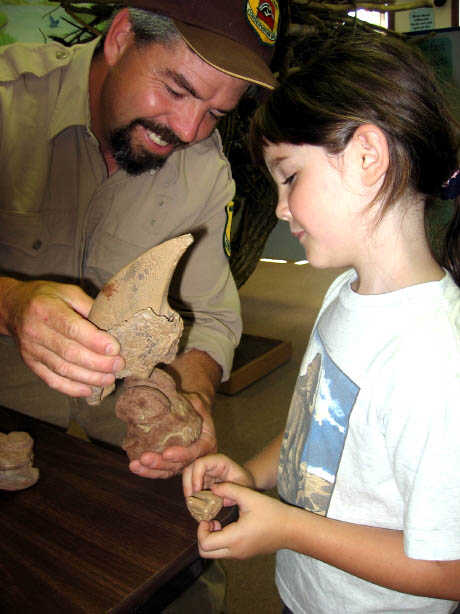 These photos came in recently from Pete Eyheralde, the Naturalist at the Mahaska County (IA) Conservation Board. He presented a couple of fossil programs this year which highlighted the sloths. Pictured: First graders at Moravia Elementary School.
These photos came in recently from Pete Eyheralde, the Naturalist at the Mahaska County (IA) Conservation Board. He presented a couple of fossil programs this year which highlighted the sloths. Pictured: First graders at Moravia Elementary School. 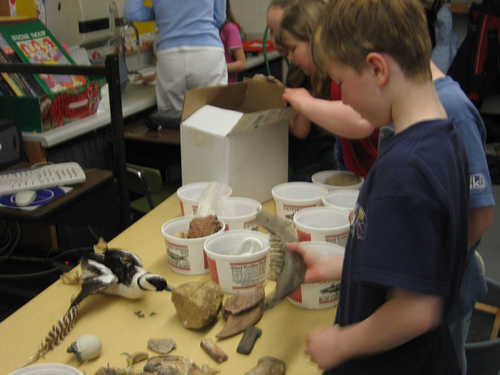
Pete is a long-time member of our Sloth Rapid Response Team, a veteran of several digs and has also assisted with fossil prep. in the lab here. (The sloth fossils in the photos are cast replicas we made here at the University just for this purpose.)
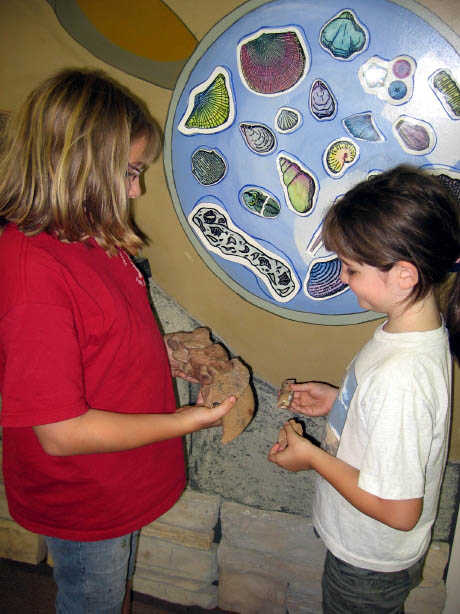 This photo is from his Nature Center and a day this summer when a group of children came out to go fossil hunting in the old limestone quarry they have there at the Russell Wildlife Area.
This photo is from his Nature Center and a day this summer when a group of children came out to go fossil hunting in the old limestone quarry they have there at the Russell Wildlife Area.
Visit his web site at http://www.mahaskaconservation.com/naturecenter/index.php. Thanks Pete.
Move over Arnold
 How big is our adult sloth? Greg McDonald says the average adult Megalonyx weighed 2,400 pounds (McDonald, 2005). That’s based on a standard formula used to approximate the weight of mammals based on measurements of their femurs, and engineering principles relating the strength of a column to its cross-sectional area. I’m a little dubious about applying the formula to sloths though. There’s nothing normal about the shape of most of their bones. Even a simple measurement like the femur’s diameter isn’t straightforward. Add a lingering uncertainty about sloth locomotion and lifestyle (bipedal vs. quadrupedal), and any weight estimate has to taken with a grain of salt. But, as Greg once told me, you have to start somewhere, and why not with the bone used in all the other mammals, and a bone that’s been recovered often enough to provide a reasonably-sized sample. If you stick to femurs, at least you can compare sloth weights in relative terms. We’ve recovered an adult femur and you’ll see a weight estimate when Meghann, our resident anatomy expert, is sure we’re measuring it from the right anatomical points.
How big is our adult sloth? Greg McDonald says the average adult Megalonyx weighed 2,400 pounds (McDonald, 2005). That’s based on a standard formula used to approximate the weight of mammals based on measurements of their femurs, and engineering principles relating the strength of a column to its cross-sectional area. I’m a little dubious about applying the formula to sloths though. There’s nothing normal about the shape of most of their bones. Even a simple measurement like the femur’s diameter isn’t straightforward. Add a lingering uncertainty about sloth locomotion and lifestyle (bipedal vs. quadrupedal), and any weight estimate has to taken with a grain of salt. But, as Greg once told me, you have to start somewhere, and why not with the bone used in all the other mammals, and a bone that’s been recovered often enough to provide a reasonably-sized sample. If you stick to femurs, at least you can compare sloth weights in relative terms. We’ve recovered an adult femur and you’ll see a weight estimate when Meghann, our resident anatomy expert, is sure we’re measuring it from the right anatomical points.
welcome
Excavation in the West Tarkio Valley of southwest Iowa has revealed the second most complete skeleton of an adult Megalonyx jeffersonii ever recovered, lying in situ, and partially intermingled, with the remains of two juveniles. The specimens are buried in primary deposits, offering unprecedented opportunities for research into paleoenvironments during the Pleistocene/Holocene transition and insights into the behavior, habitat, resource partitioning and family associations of this keystone species. See the Project Summary for more information.











